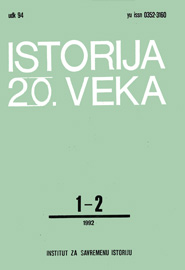ADMINISTRATIVNE GRANICE U JUGOSLAVIJI POSLE DRUGOG SVETSKOG RATA
INNER BORDERS IN YUGOSLAVIA AFTER WORLD WAR II
Author(s): Bogdan LekićSubject(s): Geography, Regional studies, Political history, Recent History (1900 till today), WW II and following years (1940 - 1949), Post-War period (1950 - 1989), Geopolitics, Politics and Identity
Published by: Institut za savremenu istoriju, Beograd
Keywords: Yugoslavia; inner borders; WWII; postwar period; administrative-territorial division; Josip Broz Tito; Croatian disputes;
Summary/Abstract: The author shows that, based on the analysis of state, party and other archival material accomplished to this day, it can safely be said that no competent state authority legally examined or issued any act (regulation, resolution, decree etc.) regulating the administrative-territorial borders between the federal units (republics) in Yugoslavia. Mr. Lekić studied the archives of those institutions which published the first post-war geographic maps bearing the earliest administrative-territorial division between the republics. These archives hold no written trace, either, of the identity of those who made such an important decision in domestic politics, nor of the time or manner in which it was made. It was supposed that some documentary material would be found in institutions for cartography since it is logical to presume that the first map of Yugoslavia was made on the basis of someone's order containing ail the information necessary for defining the borders. There is still no definite knowledge about the fate of these documents, whether they were destroyed or are still under embargo. All that can be said with assurance is that the matter of inter-republic borders was decided within the narrowest circle of Yugoslav state and party officials and with the definite participation and deciding influence of Josip Broz Tito, who then held all the highest-ranking and most responsible positions in the party, army and state of Yugoslavia. According to Mr. Lekić, there is no doubt that the administrative-territorial 'borders of the republics were never verified by competent authorities, nor were ever considered to be state borders, as Josip Broz himself often pointed out in his public speeches, saying that in a federal state administrative borders had no state or national significance. As far as the question of the demarcation of administrative-territorial borders between federal republics is concerned, the archival material has mostly been preserved. These sources clearly show that border disputes between republics began as early as the first half of 1945 and only ended in 1956. In general, these disputes were of marginal importance in relation to inter-republic borders. The most significant among them was the dispute between the People's Republic of Serbia (Vojvodina) and the People's Republic of Croatia, regarding the territoray of Bačka, Baranja and Srem. Nearly all Croatian disputes with not only Serbia but all the other republics as well, were settled in Croatia’s favor. The committees formed to work on resolving border disputes between republics emphasize in their reports that their suggestions are only a temporary solution and that the entire issue of border disputes between republics ought to be settled by a law issued on the part of competent authorities. The archival material of state institutions competent in this matter reveals no sign that his issue was ever brought up or settled in the way recommended by the committees.
Journal: Istorija 20. veka
- Issue Year: 1992
- Issue No: 1+2
- Page Range: 145-162
- Page Count: 18
- Language: Serbian

